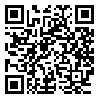BibTeX | RIS | EndNote | Medlars | ProCite | Reference Manager | RefWorks
Send citation to:
URL: http://jdm.tums.ac.ir/article-1-527-en.html
Mesenchymal- epithelial interactions during embryogenesis have been shown to be important in the fetal development of many organs. Identification of molecules that modulate these interactions is key to our understanding of the pathological conditions. The major groups of extracellular matrix (ECM) molecules characterized are glycosaminoglycans that candidate for morphogenesis and differentiation of ceils and tissues. In this study the molecules of ECM were considered in tooth development, pregnant female mice of balb-c were stained (vaginal plug=0 day) and embryos (E12-E19) and newborns (PN1-PN9) were collected. Tissues were fixed, processed embedded and sectioned. Sections were stained with the following methods: Alcian Blue (pH=l), PAS-Alcian Blue (pH=2.5), Aician Blue(pH=5.8) prepared with for MgCL2 concentrations (CEC1- CEC4) and toluidin Blue. Non- parametric statistical test (Kruskall- Wallis) showed significant difference between groups from the point of hyaluronic acid, chondroitin sulfate, carboxylated and sulfated glycosaminoglycan in pulp. It seems that the synthesis and secretion of components of ECM is important in morphogenic events and followed by a spatiotemporal pattern and developmentally regulated.
| Rights and Permissions | |
 |
This work is licensed under a Creative Commons Attribution-NonCommercial 4.0 International License. |




